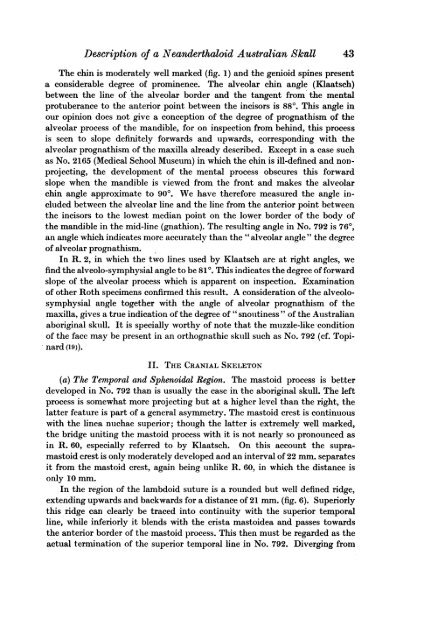THE DESCRIPTION OF A NEANDERTHALOID AUSTRA-
THE DESCRIPTION OF A NEANDERTHALOID AUSTRA-
THE DESCRIPTION OF A NEANDERTHALOID AUSTRA-
Create successful ePaper yourself
Turn your PDF publications into a flip-book with our unique Google optimized e-Paper software.
Description of a Neanderthaloid Australian Skull<br />
The chin is moderately well marked (fig. 1) and the genioid spines present<br />
a considerable degree of prominence. The alveolar chin angle (Klaatsch)<br />
between the line of the alveolar border and the tangent from the mental<br />
protuberance to the anterior point between the incisors is 880. This angle in<br />
our opinion does not give a conception of the degree of prognathism of the<br />
alveolar process of the mandible, for on inspection from behind, this process<br />
is seen to slope definitely forwards and upwards, corresponding with the<br />
alveolar prognathism of the maxilla already described. Except in a case such<br />
as No. 2165 (Medical School Museum) in which the chin is ill-defined and nonprojecting,<br />
the development of the mental process obscures this forward<br />
slope when the mandible is viewed from the front and makes the alveolar<br />
chin angle approximate to 900. We have therefore measured the angle included<br />
between the alveolar line and the line from the anterior point between<br />
the incisors to the lowest median point on the lower border of the body of<br />
the mandible in the mid-line (gnathion). The resulting angle in No. 792 is 760,<br />
an angle which indicates more accurately than the " alveolar angle " the degree<br />
of alveolar prognathism.<br />
In R. 2, in which the two lines used by Klaatsch are at right angles, we<br />
find the alveolo-symphysial angle to be 810. This indicates the degree of forward<br />
slope of the alveolar process which is apparent on inspection. Examination<br />
of other Roth specimens confirmed this result. A consideration of the alveolosymphysial<br />
angle together with the angle of alveolar prognathism of the<br />
maxilla, gives a true indication of the degree of " snoutiness " of the Australian<br />
aboriginal skull. It is specially worthy of note that the muzzle-like condition<br />
of the face may be present in an orthognathic skull such as No. 792 (cf. Topinard<br />
(19)).<br />
II. <strong>THE</strong> CRANIAL SKELETON<br />
(a) The Temporal and Sphenoidal Region. The mastoid process is better<br />
developed in No. 792 than is usually the case in the aboriginal skull. The left<br />
process is somewhat more projecting but at a higher level than the right, the<br />
latter feature is part of a general asymmetry. The mastoid crest is continuous<br />
with the linea nuchae superior; though the latter is extremely well marked,<br />
the bridge uniting the mastoid process with it is not nearly so pronounced as<br />
in R. 60, especially referred to by Klaatsch. On this account the supramastoid<br />
crest is only moderately developed and an interval of 22 mm. separates<br />
it from the mastoid crest, again being unlike R. 60, in which the distance is<br />
only 10 mm.<br />
In the region of the lambdoid suture is a rounded but well defined ridge,<br />
extending upwards and backwards for a distance of 21 mm. (fig. 6). Superiorly<br />
this ridge can clearly be traced into continuity with the superior temporal<br />
line, while inferiorly it blends with the crista mastoidea and passes towards<br />
the anterior border of the mastoid process. This then must be regarded as the<br />
actual termination of the superior temporal line in No. 792. Diverging from<br />
43

















